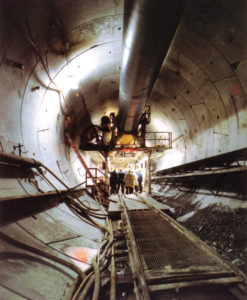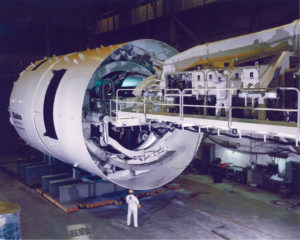![65 Years of Innovation and Experience [default]](https://www.robbinstbm.com/wp-content/uploads/2017/04/Side-Bar-Blue-Blocks_70-Years.jpg)
A Solution for Every Condition: Search our Project Database
Project Map
FEATURED PRODUCT: CROSSOVER MACHINES
Our History
A Legacy of Innovation
Information 24/7
News & Media
Insights in the Industry:
Read the Robbins Blog
 The Boston Harbor Project includes one of the largest wastewater treatment plants in the United States. The project required two undersea tunnels to carry wastewater to and from the new treatment plant. One tunnel conveys treated waste water through a 15.2 km (9.4 mi) long effluent outfall tunnel beneath Boston Harbor. The outfall tunnel transports the water from the Deer Island Treatment Plant into Massachusetts Bay. Since the completion of the project in 1998, effluent discharges into Boston Harbor have ceased and concentrations of toxic bacteria, waste solids, and nitrogen have decreased dramatically.
The Boston Harbor Project includes one of the largest wastewater treatment plants in the United States. The project required two undersea tunnels to carry wastewater to and from the new treatment plant. One tunnel conveys treated waste water through a 15.2 km (9.4 mi) long effluent outfall tunnel beneath Boston Harbor. The outfall tunnel transports the water from the Deer Island Treatment Plant into Massachusetts Bay. Since the completion of the project in 1998, effluent discharges into Boston Harbor have ceased and concentrations of toxic bacteria, waste solids, and nitrogen have decreased dramatically.
In 1990, The Massachusetts Water Resource Authority awarded the construction contract to Kiewit-Atkinson-Kenny Joint Venture. The contractors selected an 8.1 m (26.5 ft) diameter Robbins Double Shield TBM to bore and install the lining in the effluent outfall tunnel.
The prominent rock type along the tunnel is Cambridge argillite in beds 1 mm to 8 cm (.04 to 3.15 in) thick with occasional 1.5 m (4.9 ft) formations. Volcanic flows and occasional tuff deposits are also embedded in the argillite. Other geologic features include igneous dikes and sills of diabase with some basalt, andesite, and felsite.
Robbins built the Double Shield TBM to handle the variable geology of the undersea tunnel. While in “double shield mode” the machine simultaneously installed pre-cast concrete lining segments while excavating. This feature gave the machine a faster overall advance rate than with the sequential operation of “single shield mode”.
The machine’s cutterhead drive consisted of eight electric motors generating 2520 kW (3360 hp) and supplying 3665 kN-m (2,700,000 lb-ft) of torque to the cutterhead. The cutterhead thrust was 111,350 kN (2,500,000 lb) and the machine’s 50 – 17 in (432 mm) diameter cutters could be changed from behind or in front of the cutterhead.
The source of cutterhead thrust could also be changed depending on boring conditions. In good conditions (self-supporting ground, usually hard rock), the machine would bore in “double shield mode,” where thrust reacted through a conventional gripper system into the tunnel walls. In soil or fractured zones where the tunnel walls were too weak, the machine would operate in “single shield mode”, where the thrust reacted directly to the tunnel lining segments via a set of auxiliary cylinders in the tail shield.
The TBM towed a back-up train with eight 10.7 m (35 ft) long double-deck gantries, via hydraulic cylinders. The upper decks of the gantries housed the two main 2000 kVA transformers, electrical control cabinets, dust scrubber system and auxiliary equipment. Flexible 1.5 m (4.9 ft) diameter ducting extended from a storage cassette mounted on the last back-up gantry to provide ventilation. A double-track rail system installed on the first six gantries provided storage for rail cars carrying pre-cast segments and pea gravel for temporary segment support, rails and ties.
 The TBM began excavating from the access shaft in July 1992. Early in the drive, the TBM battled more blocky rock than predicted in the geological reports. Hard rock and water inflows continued to slow progress throughout the drive.
The TBM began excavating from the access shaft in July 1992. Early in the drive, the TBM battled more blocky rock than predicted in the geological reports. Hard rock and water inflows continued to slow progress throughout the drive.
In 1993 and again in 1995 and 1996, hard rock and heavy water inflows required face grouting and slowed TBM progress. Most of the water inflows reached rates of 19,000 to 26,600 liters (5,019 to 7,027 gallons) per minute. Probe drilling and grouting in these sections resulted in slower TBM advance rates.
From March 1996 onward, TBM excavation continued concurrently with hand excavation of the crossover adits. The machine broke through on September 19, 1996 after excavating over 15 km (9.3 mi). The TBM achieved a best day of 44.2 m (145 ft) and a best week of 195.1 m (640 ft).
This TBM’s achievements are remarkable considering the extremely high volume of water inflow and large variations in geology throughout the drive.

 Close
Close